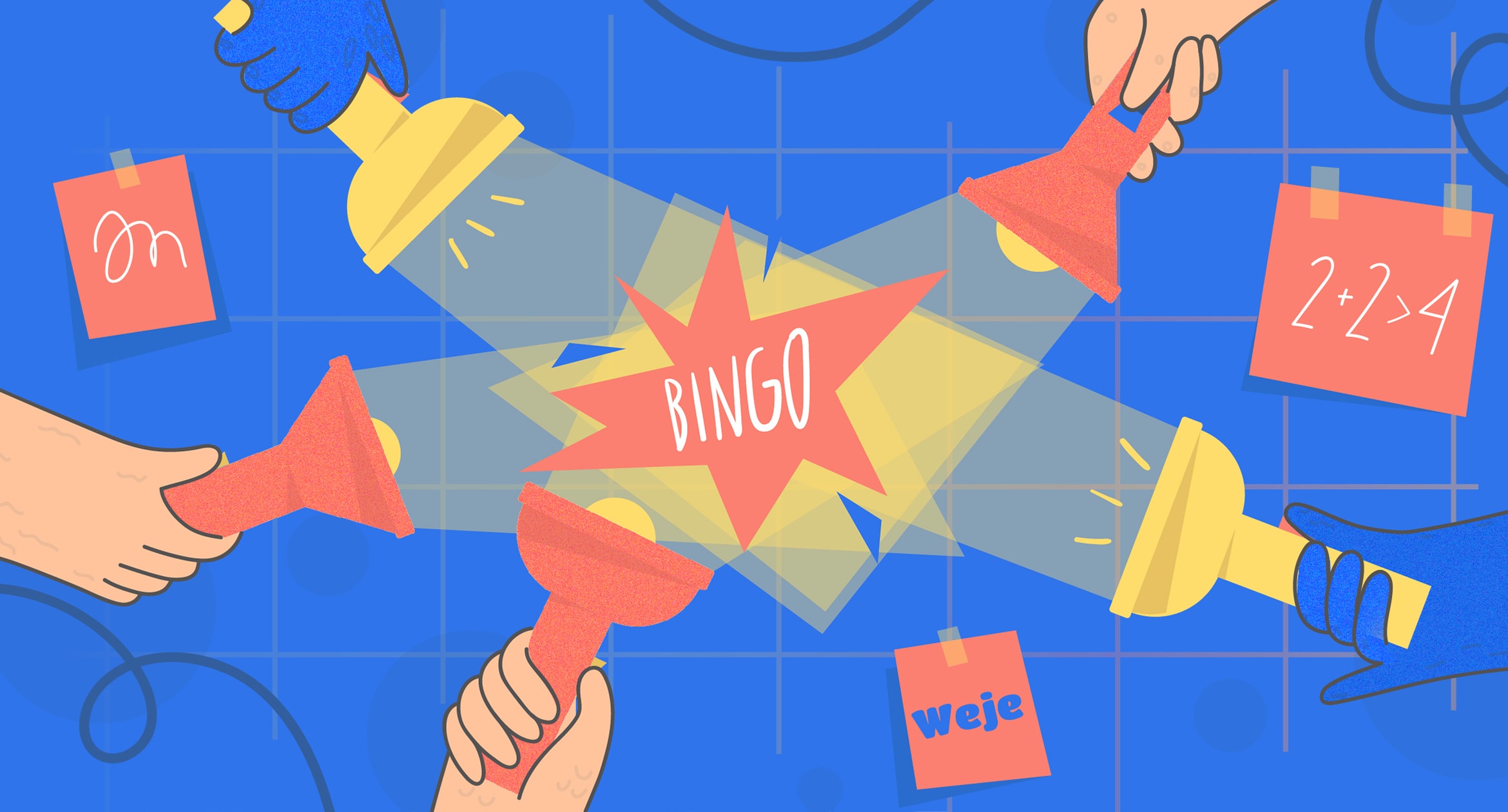If someone asks you “What does brainstorm mean”, what will be the first idea appearing in the mind?
We bet it’ll be a thought of a round table – people sitting around and enthusiastically tossing about ideas with one another. The atmosphere will probably seem loud and a bit messy, with coffee cups, half-eaten snacks, and product samples scattered over the table. Perhaps, scenes from Hollywood movies will pop up in your imagination, as well. Remember – those where personages produce glorious ideas after somewhat laughable trials?
Whatever your definition of brainstorming will be, it’ll by far carry the following thought – “A brainstorm is when people try to come up with something together”. Well, it is and it isn’t. Let’s unpack this in detail.
What is brainstorming?
Brainstorming is the process that supposes generating ideas and happens between at least two vis-a-vis. This is an example of how the synergy effect (when “2 + 2” equals more than 4) exists in real life.
Brainstorming definition first appeared in 1953, when Alex Faickney Osborn introduced the term in his book “Applied Imagination”.
One may doubt the exact year, as Wikipedia provides another date – 1942 year and “How To Think Up” book, written by the author of the same name. Anyway, it’s obvious that a technique we consider contemporary was conceptualized far back in the days of the Cold War and hippies.
Mr. Osborn presented a method he used when working at BBDO – a giant advertising agency, that still operates and has an extensive list of honorable nominations, including ones from the Cannes Lions International Festival of Creativity. He decided to overcome the lack of individual creativity and originated collective strategic sessions. BBDO’s creative managers met together and worked out thoughts with a “collective mind”. Thus, “the brain to storm a problem” approach has loomed.
The scheme was as follows: regardless of how ridiculous a particular idea seemed to cooperators, it must have been taken into account for consideration. It was strictly forbidden to question or discuss ideas at the very first stage of brainstorming – all were perceived on parity and granted equal chances to be shortlisted.
Additional Osborn’s suggestion was to handle joint sessions in a proper environment, which was favorable to creativity and didn’t lead to confrontation. This turns into the following relevant statement: brainstorming to the large extent depends on the composition of a working group.
Now, in 2021, brainstorming meaning is neither a rambling nor a conventional set of exact stages and procedures. In fact, it’s somewhere in between. Economics and Innovations Management, as well as Probability Theory and Statistics, have enriched Osborn’s concept with accurate data gathering and analyzing tools, like ones you can teach on Brainstorming course from Coursera or find out in this article.
Benefits of brainstorming
Understanding of benefits starts with answering the question “What is the main purpose of brainstorming?”. The goal is – to develop a proper solution to an issue, or use an opportunity efficiently. Brainstorming presupposes achieving the goal by encouraging out-of-the-box and lateral thinking – in all participants.
It’s essential to stress that mere information exchange between team members, by email or in verbal form, isn’t a brainstorming. The process is not about communicating individual ideas, but about piggybacking and modifying them collectively – in a way no one alone could ever think of. Hence, the technique has the following significant benefits:
- brainstorming helps to set in motion problem-solving through individual creativity
- since a group of people delivers the solution to a certain issue, the risk that a problem will be considered one-sidedly is reduced to almost zero
- brainstorming encourages cohesiveness and commitment
- it allows increasing individual engagement, as far as pretty any idea may become the “winner”.
Like any approach with public awareness, brainstorming is being criticized. In particular – for a lack of judgment during the process. This, supposedly, makes it difficult to distinguish correct courses from trashy ones on further, analytical, stages. However, because brainstorming is not just about ideas, but about teamwork as well, the method has much more admirers than ill-wishers.
How to brainstorm – main stages
Let’s consider Mr. Osborn’s guidelines on the process flow. The technique assumes dynamic intercommunication between people. A moderator handles and leads the discussion, and he or she is also responsible for jotting down voiced ideas.
Brainstorming stand on three wales:
- The process
What distinguishes this technique from a discussion is a particular issue description. The word “issue”, in this case, may or may not have a negative connotation – it’s just something to be discussed and solved. For example, a problem statement in a digital ads agency may begin with the words “We’ve got a new client’s order and need to come up with the design and message for brand-building email campaigns….”.
Participants shall clearly understand the purpose of the meeting and agenda, hence, a moderator outlines rules and timing at the beginning of a brainstorm session. Few recommendations in the matter for organizers:
- do not overdo and drag out the session – in most cases, 60 minutes are more than enough for a brainstorming loop
- do not put multiple questions on agenda – scattering efforts will reduce the outcome to zero
- pay attention to the place – make sure there is a whiteboard, flipchart, or other handy tools for visuals; although keyboards and HD wide screens seem more convenient, when it comes to creative thinking – for some reason it’s better to keep writing by hand
- focus on quantity – the technique is about collecting as many ideas from participants, as possible; keep your eye on the ball – don’t let judgments or phrases like “It’s too….[expensive, silly, impossible]” appear.
- The team
The size of the brainstorming panel may vary, however, it’s better to aim for 10-12 people. The too low number of participants may not bring enough ideas, while multitudes are difficult to manage. Furthermore, a division into groups may happen – when more active participants discuss among themselves, while less active ones befall on the sidelines.
- The analysis
Idea processing is no less significant than idea generation. Remember, the effective brainstorm session is the one you left with at least one usable solution in mind. Otherwise, we can say that the time was spent with pleasure, but without benefit for the cause.
After every participant has voiced an opinion, it’s time to elaborate and build them further. A good way is to use the association method. Avoid anchoring effect, when the first couple of opinions capture everyone’s attention, and conversation is built exclusively over these.
Types of brainstorming
Depending on the purposes, you can try different brainstorming ideas:
- Silent
For some reason, it may be difficult or impossible to push members to chat with one another aloud. For example, if the group is over heterogeneous and includes bosses and subordinates, or introverts. In this case, it’d be better to prevent possible awkwardness and pre-set “quiet” rules of the game.
The realization is pretty simple. First, state the topic to think about and give participants pieces of paper, so that they can write down notions. Then – all ideas are assembled in a single “pool” and reviewed, and a further action plan is developed.
- Reverse
This is a very interesting technique because it presumes thinking from the opposite. Instead of asking for solutions, ask participants to develop a failure scenario. People need to think about what actions will cause a negative result – not a desired one. Use questions like:
- How could we cause the problem?
- Describe the worst case and factors that can make it happen.
If you worked out a “bad” scenario, you would see clearly options that lead to success. Of course, reverse brainstorming has limited application, due to its method specificity.
- Stop-n-go
It’s not a completely distinct type – stop’n’go approach can be merged with other brainstorming scenarios. Unlike the conventional flow suggests, here ideas’ judgment accompanies their sounding with short intervals, for example, 10 minutes. The entire session is, thus, split into cycles. Each 10-minutes cycle ends up with selecting the best option. Afterward, the overall “winner” is defined.
- Role storming
This the most creative brainstorming scenario, indeed. It is based on human psychology, that is when a person acts on behalf of somebody else, he or she may change behavioral patterns. In terms of generating ideas, this means people become more liberated and brave, hence, can think out-of-the-box.
The moderator asks participants to “pretend” with somebody else and communicate ideas on behalf of fabricated personalities. These may be clients, suppliers, C-level managers, and even superheroes or aliens.
- Phillips 66
This method has nothing to do with household appliances. The name has originated from a creator, Donald Phillips, who first suggested the 6×6 discussion technique. The principle is simple: large groups are divided into subgroups of 6 people, and each smaller group addresses the proposed issue within 6 minutes. Then – developed solutions are presented to a wide audience. Phillips 66 and related principles are the only manners a brainstorming can be managed within big collectives.
- Analytics
Like stop-n-go brainstorming, this approach can be used in combination with other types – to obtain better results. Participants use various helpful tools, such as BCG matrix or SWOT analysis, to compare outcomes with one another. However, the basic concept remains untouched – to accumulate diverse ideas and not to judge them initially.
Effective brainstorming techniques
Which factor is important while brainstorming – deferred judgments, ideas quantity, collaborative environment, or working group structure? There is no universal answer to this question, most likely, these all perform in a mixture. To get close to 100% efficiency, apply 6 brainstorming best practices:
- Quick notes
This technique is useful to prevent people from thinking for too long on particular ideas and starting to cross out “irrelevant” ones. The trick is to ask participants to write down as many ideas as they can – during a limited amount of time. Timeframes are key – they neither need to be extended nor too short, otherwise, an undesirable urgency will transpire.
Brainstorm with Weje
Here’s an example of how you can mark your sticky notes/cards in colour for roles/names division. We did such an online whiteboard for our team, just marked our ideas the colour we wished and started our brainstorm session. You can do that with an emoji before the name as well or go to Kanban mode where everyone will have their own columns. Just try it!

- Sampling
Humans think in pictures, but sometimes they lack the best words to describe these. Visuals, color schemes, sticky notes, various physical details – these will be exceptionally helpful if you use brainstorming to work out product concepts.
- Brainstorming template
Although the process is quite straightforward, there are many small details that influence brainstorming efficiency. In order not to get bogged down in preparation, use pre-designed templates – mind maps, diagrams, and matrixes.
You can also use an online whiteboard like Weje – to better organize and quickly share ideas and come up with thoughts more commonly.
- Brain netting
Although first brainstorms were handled offline solely (times with no Internet were not so long ago), now, in the era of advanced communication tools and remote teams, virtual brainstorming tools have become extremely popular. Online video conference hosters, chatting tools like Slack, project-collaborative tools like Trello, AI-powered tools like Vondy’s Idea Generator, mind map makers, and online whiteboards – these enhance brainstorming web activities as never before.
- Step-ladder technique
The process presumes all participants, except two people, leaving the room after the brainstorming subject was announced by the moderator. After the 2 have discussed the issue for, say, 10 minutes, the third participant joins them in a room. Then, after a while, the 4th person joins the discussion. And so on and so forth.
The step-ladder technique is used to prevent ideas from mixing with one another too hasty. Because each next participant isn’t aware of what teammates have already discussed, he or she can bring new, unprejudiced input to the joint process.
- Starbursting
Every idea is worked out by 6 questions: What? Where? When? Who? How and Why? Participants try to answer each so that they come to a complete concept.
Starbursting brainstorming is used on advanced stages of a process – to embellish ideas from the shortlist.
Wrapping up
Regardless of how you define brainstorming, it continues to be kind of an artistic process – with no changeless precepts or rigid procedures. Nevertheless, in order to turn this exercise into a regular instrument for generating ideas, either for business or for non-commercial purposes, it’s more salutary following well-known best practices.





